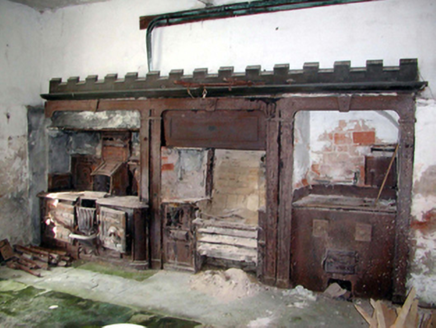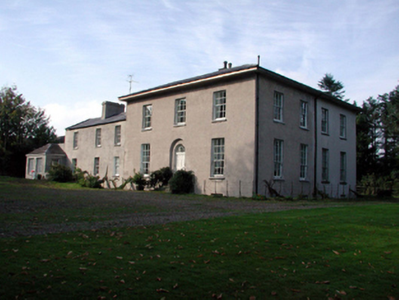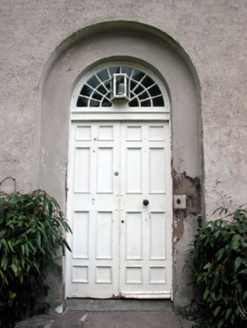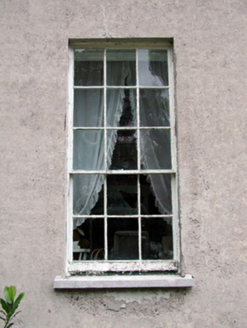Survey Data
Reg No
22902802
Rating
Regional
Categories of Special Interest
Architectural, Artistic, Historical, Social
Original Use
Country house
In Use As
Country house
Date
1800 - 1841
Coordinates
200891, 92024
Date Recorded
01/10/2003
Date Updated
--/--/--
Description
Detached three-bay (four-bay deep) two-storey over part raised basement country house, extant 1841, on a T-shaped plan; three-bay two-storey wing (south). Occupied, 1901; 1911. Undergoing restoration, 2003. Hipped slate roof on a U-shaped plan with clay ridge tiles, rendered chimney stacks having capping supporting yellow terracotta pots, and no rainwater goods surviving on slightly overhanging timber box eaves retaining cast-iron downpipes; pitched slate roof (wing) with clay ridge tiles, rendered chimney stacks having stringcourses below capping, coping to gable (south), and cast-iron rainwater goods on rendered eaves retaining cast-iron downpipes. Rendered, ruled and lined walls. Round-headed central door opening in round-headed recess approached by flight of four cut-limestone steps with concealed dressings framing timber panelled double doors having fanlight. Square-headed window openings with drag edged dragged cut-limestone sills, and concealed dressings framing nine-over-six (ground floor) or six-over-six (first floor) timber sash windows without horns. Square-headed window openings (wing) with cut-limestone sills, and concealed dressings framing six-over-six timber sash windows. Set in landscaped grounds with limestone ashlar piers to perimeter having stringcourses below monolithic capping supporting wrought iron double gates.
Appraisal
A country house erected by Reverend William Perceval (1787-1880) representing an important component of the early nineteenth-century domestic built heritage of County Waterford with the architectural value of the composition, one described (1837) as 'Kilmore Hill…a handsome seat on the new line of road to Youghal' (Lewis 1837 II, 589), confirmed by such attributes as the deliberate alignment maximising on scenic vistas overlooking wooded grounds with a rolling backdrop in the near distance; the compact plan form centred on a restrained doorcase showing a simple radial fanlight; the diminishing in scale of the openings on each floor producing a graduated visual impression; and the slightly oversailing roofline. Having been well maintained, the form and massing survive intact together with substantial quantities of the original fabric, both to the exterior and to the interior, including crown or cylinder glazing panels in hornless sash frames: meanwhile, contemporary joinery; and plasterwork refinements, all highlight the artistic potential of the composition. Furthermore, adjacent outbuildings (see 22902812); and a nearby gate lodge (see 22902813), all continue to contribute positively to the group and setting values of a self-contained estate having historic connections with the Perceval family including Richard Perceval (1819-98) 'late of Kilmore Hill Tallow County Waterford' (Calendars of Wills and Administrations 1898, 403); William Perceval (1825-1905), 'Civil Engineer late of Kilmore Hill Tallow County Waterford' (NA 1901; Calendars of Wills and Administrations 1905, 410); and Brigadier-General Claude John Perceval CB CMG DSO (1864-1932) '[of] Kilmore Hall [sic] Tallow County Waterford' (Thom's Irish Who's Who 1923, 203).







